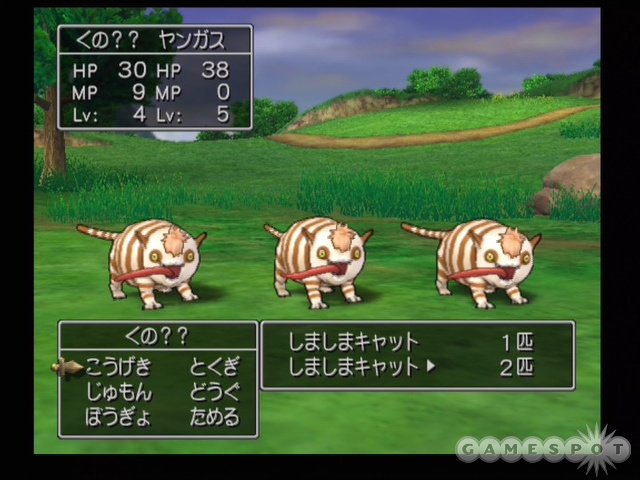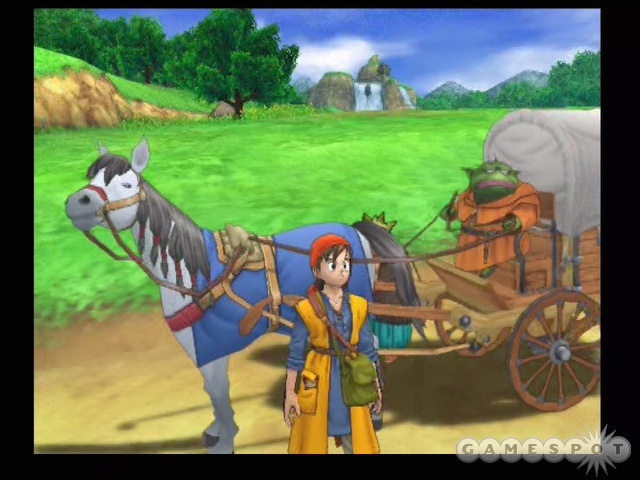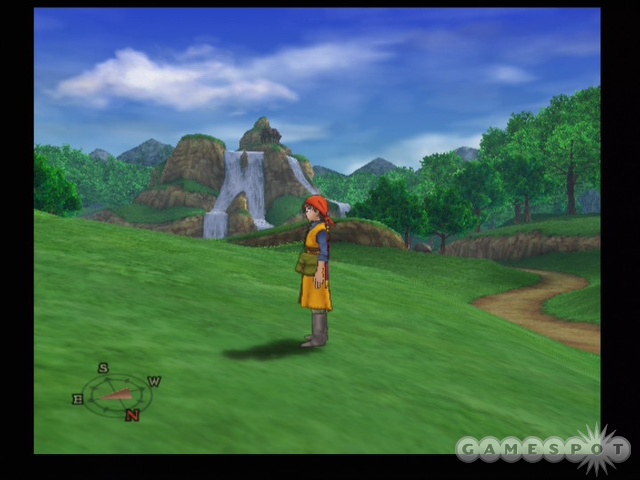Dragon Warrior VIII Import Impressions
A new Dragon Quest game has at last arrived, and we've got impressions of our time spent with the import.
We know the Dragon Quest series on these shores as Dragon Warrior, though the epic role-playing games don't enjoy the same instant familiarity in North America as they do in Japan. This past weekend, Dragon Quest VIII finally made its debut in "The Land of the Rising Sun" on a Saturday, because there's a Japanese law that forbids the sale of Dragon Quest games on weekdays. We obtained an import copy of the game and promptly jumped into our own adventure just to see how the passage of time and the translation to a 3D graphics engine has affected this venerable series. As you play Dragon Quest VIII, two things are immediately apparent. One, the cel-shaded characters and fully 3D environments make for an artistically cohesive, wonderful-looking game. And two, beneath all the newfound glamour, this is still the Dragon Quest of yore.

After beginning a new adventure, you'll name your hero and promptly get right into the thick of things by being dropped into a camp with your traveling companions. Yangus is a rotund but battle-ready warrior with a keen axe and a barbarian's sense of fashion, while Trode is a short, green creature in possession of a small wagon and a horse, the latter of which he is inordinately fond of. Not a few sentences pass between the group (speech here is all in text, with no voice work) before a group of menacing--but still smiling and adorable--slimes bounce into camp to give you and your friends your first workout.
The battle system employed here is virtually identical to the setup in previous games in the series, so if you've played any of the Dragon Quest RPGs, you'll be right at home. Monsters will array themselves in front of you in a neat line, and then it's just a matter of deciding what to do. You can choose to fight your foes, run from battle, attempt to intimidate them, or adjust your party members' tactics as necessary. And, as in previous games, you still don't directly control other characters by default, though you can choose to give them subcommands. If you choose to fight, you can attack directly, defend, or use a special ability, magic, or items. Once you've chosen what to do, you watch the action unfold. In Dragon Quest VIII, you'll actually see your characters on the battlefield as they leap forth to strike at monsters and such, whereas in previous games in the series, you'd remain in a fixed first-person view of the monster formations. The monsters here aren't static, two-dimensional representations anymore, either. They're all fully 3D, and they're all animated smoothly. You'll see the ubiquitous slimes hop and jiggle around in their own jellylike way; the cute, batlike drakees will flap their wings and writhe their spaded tails; and the other monsters in the game similarly come to life with their own various animations, dances, and special spells and attacks. You'll enter into battle through random encounters on the field, as well as through encounters with the occasional roaming fiend that you'll spot on the map. If you move into range of such a foe, you'll automatically engage in battle, but remember that said creatures tend to be stronger than normal.
When roaming around the landscapes, villages, dungeons, and other areas of the world, you can bring up a command menu at any time to select from a variety of options. You can choose to talk to a nearby character, use a magic spell (such as heal), manage your items (your characters still have their own separate item inventories), talk to a party member to gather information and clues, and otherwise check your status. If you don't want to delve through a number of menus, you can still interact with people and objects by pressing the triangle button, which lets you chat with nearby non-player characters. Additionally, the triangle button lets you pick up vases that you can smash to reveal hidden goodies, and you can even pluck a book off someone's bookshelf to peruse its pages.

You'll find yourself lingering around various areas in hopes of becoming involved in just such player-environment interactions, because the game's world itself is a captivating place. Artist Akira Toriyama of Dragon Ball fame has always been the character artist for the Dragon Quest series, but never before has his unique art style been so well realized within a Dragon Quest game. From your party members, to the various NPCs you'll meet, to the monsters and beasts you'll face, they're all stamped with Toriyama's design. The game uses a cel-shaded look for its characters that's very textured, as opposed to being simply cartoony and flat. Consequently, the animation really brings these characters to life. You'll guide your main character through all the villages and outdoor areas (party members don't appear with you in the field), and you'll be able to rotate your camera as you go to ensure you don't miss anything. The environments are also detailed, and they let you wander through vast, rolling hills replete with winding paths, the odd grazing sheep, waterfalls, and other landmarks and ambient details. The occasional treasure chest hides in the great outdoors, so it's worth it to spend some time wandering around the vast outdoor areas to discover secrets. In fact, a dungeon we visited cut a cavernous path beyond mountain pools and rock formations, culminating in the appearance of an imposing merman who quickly sent our party packing.
If your party members all die, it's not game over, either. You'll be resurrected in the church where you last saved, complete with any levels gained and any items found, but minus half your money. Furthermore, churches will also resurrect individual party members and cure you of poison or curses...for a fee. Still, with the most valuable commodities in role-playing games, and Dragon Quest games in particular, being gained levels and time, it's nice to not lose (almost) everything if you happen to wipe out unexpectedly.
Longtime fans of Dragon Quest will easily recognize much of the music and many of the sound effects used in the game, from the opening theme, to the fanfare that sounds when a character gains a level, to the tune that plays when you rest at an inn, and more. These sounds all have fresh edges to them, so they're pleasantly nostalgic-sounding rather than seeming recycled outright. There's still original music as well, of course, and much of it is light and invigorating, thus perfectly setting the stage for adventure.

Those considering an import of this game should keep in mind that, as in all RPGs, there's quite a bit of text to go through. And, of course, here it's all in Japanese. Our time spent with Dragon Quest VIII only served to whet our appetites even more for an eventual English-language release of the game. With no definite date yet announced, those yearning for a Dragon Quest fix can still check out our new movies and screenshots of the import version. For news on the North American release of Dragon Quest VIII, keep your eyes glued to this gamespace.
Got a news tip or want to contact us directly? Email news@gamespot.com
Join the conversation